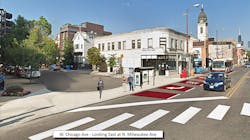Chicago Transit Authority (CTA) bus service is being prioritized through a series of projects to be completed this year aimed at improving pedestrian safety and the flow of traffic along Chicago's most heavily traveled corridors.
The city has allocated $5 million toward the new Bus Priority Zones program designed to unsnarl bus slow zones and improve service along entire bus routes. The initiative checks multiple boxes for the city including acting as one of the first projects implemented based on recommendations made by Chicago Mayor Rahm Emanuel's New Transportation and Mobility Task Force, as well as supporting the city's efforts to meet its climate goals under the Chicago Climate Charter and as one of 25 cities participating in Bloomberg Philanthropies' American Cities Climate Challenge. As part of the challenge, Chicago is advancing a suite of actions in transportation, including encouraging low-carbon mobility options, developing policies that support transit ridership and defining and expanding the high-frequency public transit network.
In early April, the Chicago City Council approved a resolution to transition to 100 percent renewable energy by 2035 with the CTA bus fleet to be 100 percent electric by 2040.
The city says improvements made under the Bus Priority Zone program may include street resurfacing work and establishing designated bus-only lanes along certain stretches of the corridor to improve bus service during weekday rush periods or all-day, depending on the specific location. The designated lanes will be indicated with new pavement marking and signage.
Other program elements include queue jump signals to give buses a head start to get in front of regular traffic, optimizing the location of bus stops, as well as improvements that support pedestrian safety and overall traffic flow for all vehicles.
The first project to be started under the Bus Priority Zone program will be at the intersection of Chicago/Milwaukee/Ogden – one of the busiest bus boarding locations in Chicago during rush periods, on one of the highest ridership and highest frequency bus routes in the CTA system. The eight-week project will begin immediately and include street resurfacing, new signage and the reconfiguration of May Street into a cul-de-sac, which will improve the safety and flow of traffic at the intersection and also provide an extended and safer bus boarding area for riders.
“Improving the speed and reliability of bus service has been one of my top priorities, and this new funding will help us accomplish that goal on two of our busiest routes the #66 Chicago and #79 79th,” said CTA President Dorval R. Carter, Jr. “With our buses providing roughly half of our system ridership, it’s vital that we make these investments and find ways to keep Chicago a thriving and livable city on the move.”
The city explains that the #79 79th Street bus route, with 7.8 million rides in 2017, and #66 Chicago Avenue bus route, with 6.9 million rides, were selected for the initial improvements based on CTA and Chicago Department of Transportation (CDOT) studies that looked at a host of factors, including service coverage, ridership, operations, population/employment and feasibility.
“By making these targeted investments, our goal is to speed up bus service, improve reliability, increase ridership and customer satisfaction and lower costs for the CTA,” CDOT Commissioner Rebekah Scheinfeld said. “By doing a better job of organizing bus movements, we can also improve pedestrian safety and the overall traffic flows on Chicago Avenue, 79th Street, Western Avenue and other high-volume locations.”
In addition to the Bus Priority Zone work on 79th and Chicago Avenue, additional targeted investments have been identified for other high volume locations, such as Western Avenue and downtown intersections that serve multiple bus routes, as part of the Mayor’s proposal to extend transit oriented-development for buses. Transit signal priority on Western Avenue is also planned to be completed by the end of 2019.
About the Author

Mischa Wanek-Libman
Group Editorial Director
Mischa Wanek-Libman is director of communications with Transdev North America. She has more than 20 years of experience working in the transportation industry covering construction projects, engineering challenges, transit and rail operations and best practices.
Wanek-Libman has held top editorial positions at freight rail and public transportation business-to-business publications including as editor-in-chief and editorial director of Mass Transit from 2018-2024. She has been recognized for editorial excellence through her individual work, as well as for collaborative content.
She is an active member of the American Public Transportation Association's Marketing and Communications Committee and served 14 years as a Board Observer on the National Railroad Construction and Maintenance Association (NRC) Board of Directors.
She is a graduate of Drake University in Des Moines, Iowa, where she earned a Bachelor of Arts degree in Journalism and Mass Communication.
